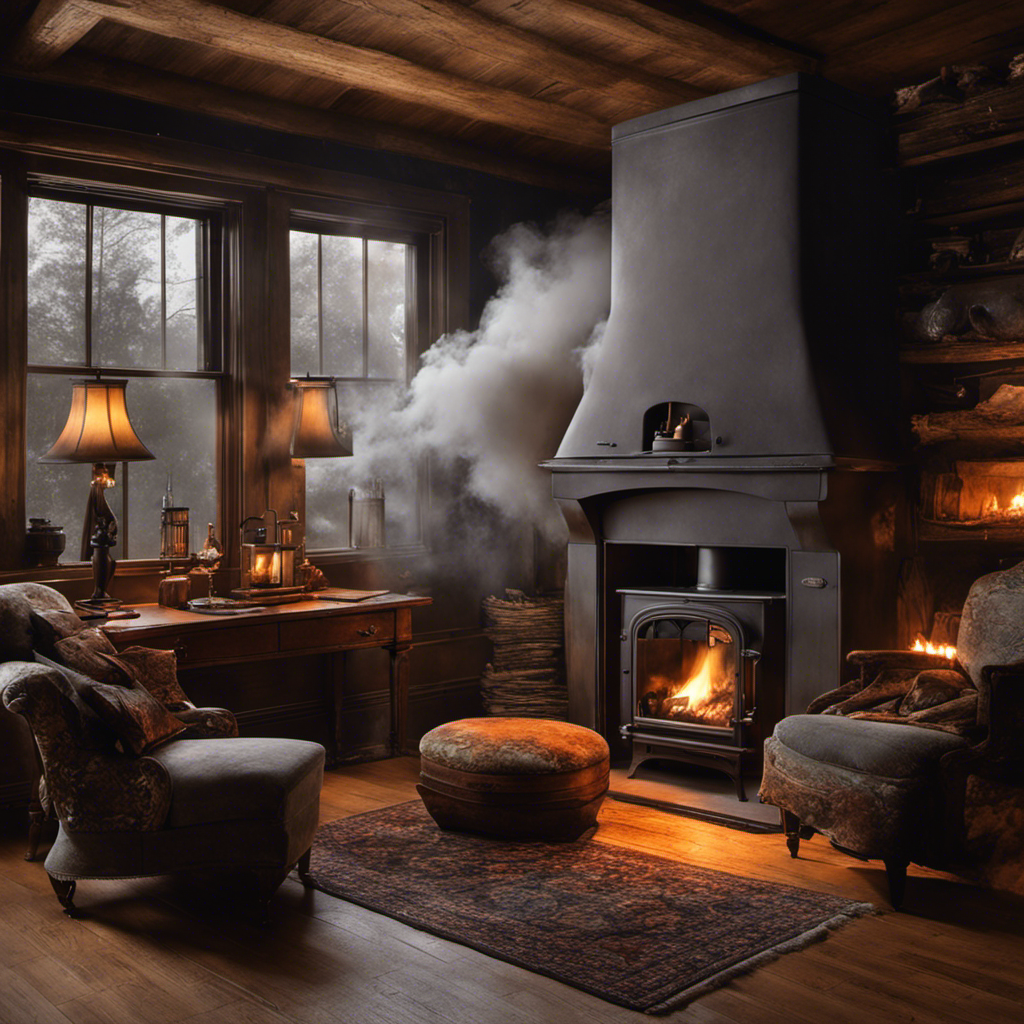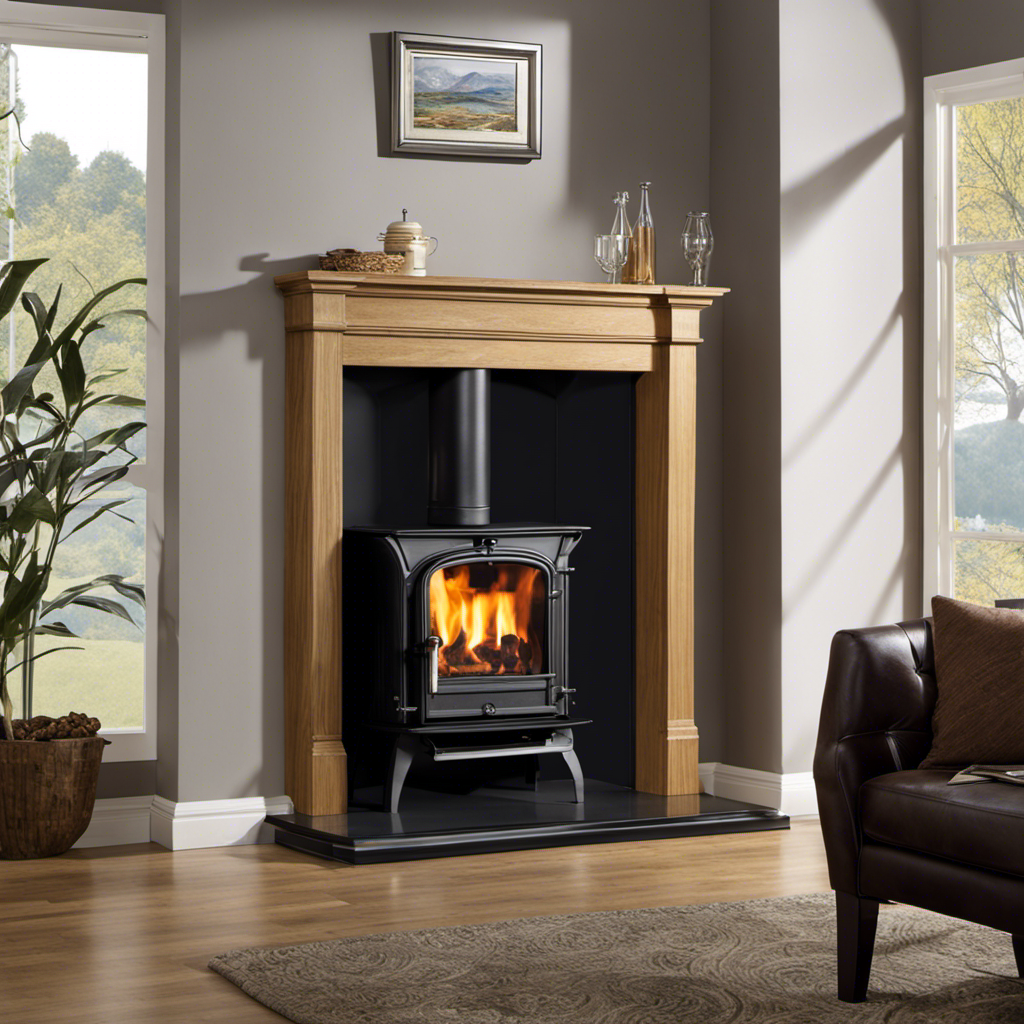Wood stoves are often surrounded by myths that can mislead you. For instance, modern stoves are designed to be eco-friendly, emitting primarily the carbon previously absorbed by trees. They can retain heat efficiently—up to 85%—unlike traditional open fires. Professional installation is essential for safety, while regular maintenance keeps your stove running smoothly and minimizes smoke emissions. Additionally, using properly seasoned wood improves air quality and performance. By separating fact from fiction, you'll better appreciate the benefits of wood stoves. Stick around, and you'll uncover even more surprising truths about their efficiency and environmental impact.
Key Takeaways
- Modern wood stoves are renewable, emitting only carbon absorbed by trees, and can operate legally in smoke-controlled areas with clean-burn technology.
- Wood-burning stoves retain 70%-85% of heat, significantly outperforming open fires that waste about 80% of their heat.
- DIY installation of wood stoves can pose safety risks; hiring HETAS-trained professionals is essential for compliance and safety.
- Proper maintenance, including regular chimney sweeps and airflow checks, is crucial for maximizing efficiency and reducing emissions.
- Advanced technologies in modern stoves lead to a dramatic reduction in emissions, contributing only 1-2% to overall PM2.5 levels compared to traditional fires.
Common Myths About Wood Stoves
When it comes to wood stoves, many myths can cloud your understanding of their benefits and efficiency. One common misconception is that wood-burning stoves are detrimental to air quality and the environment. In reality, modern wood-burning stoves emit only the carbon that trees absorbed during their growth, making them a renewable heating option.
Additionally, using a well-maintained wood stove can provide benefits of diversification in your home energy strategy. Another myth is that you can't use wood burners in smoke-controlled areas. However, many modern stoves feature clean-burn technology, allowing you to operate them legally and effectively.
You might also hear that open fires produce more heat, but that's misleading. Open fires waste about 80% of their heat through the chimney, while wood-burning stoves retain 70%-85% of their heat when closed, making them much more effective.
Additionally, some believe that DIY installation is safe, but it's essential to have HETAS-trained professionals handle the installation to avoid hazardous leaks and guarantee safety.
Lastly, you may think wood stoves require frequent cleaning. Thanks to clean-burn technology, build-up is considerably reduced, and regular maintenance keeps them running efficiently.
Understanding Wood Stove Efficiency
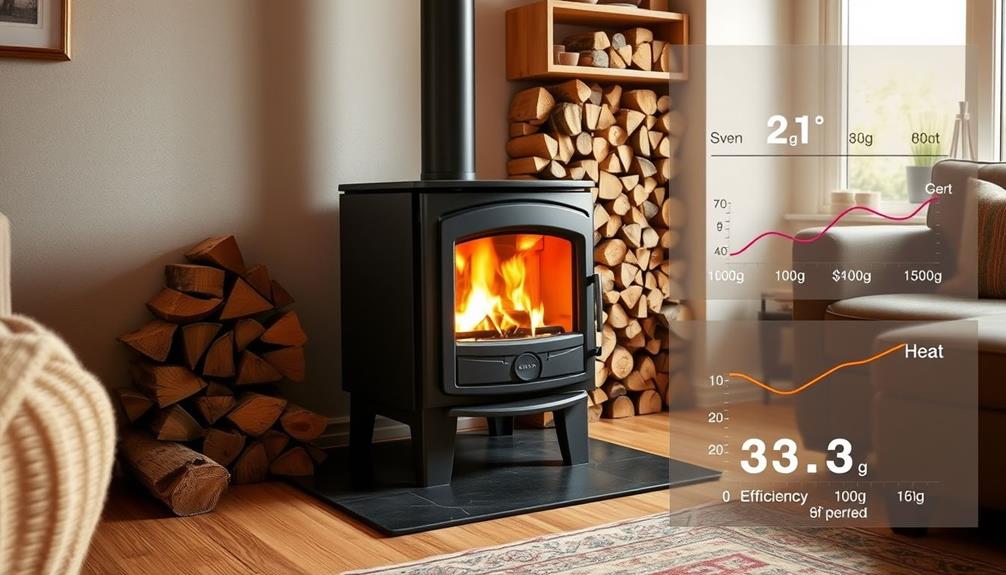
When it comes to heating your home, wood stoves offer a level of efficiency that far surpasses open fires.
For instance, modern wood pellet stoves, such as the Englander 10-Cpm, can generate up to 50,000 BTUs, making them suitable for heating large areas while maintaining high efficiency levels of approximately 85% high-efficiency rating.
To get the most out of your stove, proper maintenance is essential, ensuring peak performance and safety.
Understanding these aspects can help you enjoy a warm home while minimizing your environmental impact.
Efficiency Compared to Open Fires
Compared to open fires, wood-burning stoves offer a remarkable boost in efficiency, retaining 70% to 85% of heat when closed. In contrast, open fires lose about 80% of their heat through the chimney, making them a poor choice for heating your home effectively.
Modern wood stoves, especially those with clean-burn technology, are considerably more efficient than traditional open fires, meaning you'll use less fuel while enjoying better warmth. As with other renewable energy sources, such as geothermal energy, the advancements in wood-burning technology focus on reducing emissions and improving overall performance.
Burley stoves stand out as some of the most efficient wood-burning stoves available, designed to maximize heat output while minimizing emissions.
If you're concerned about air pollution, upgrading to the latest Ecodesign stoves can make a huge difference. These models emit up to 90% fewer particulates compared to open fires, greatly improving air quality in your home and the environment.
Importance of Proper Maintenance
Proper maintenance of your wood stove is vital for guaranteeing its efficiency and safety. Regular upkeep helps prevent creosote build-up, which can cause chimney fires and reduce the stove's effectiveness. By taking care of your wood-burning stove, you can enhance its lifespan and operate it at peak performance, cutting emissions by up to 90% compared to open fires.
Here's a quick reference table to guide your maintenance routine:
| Maintenance Task | Frequency | Benefits |
|---|---|---|
| Chimney Sweep | Annually | Prevents creosote build-up |
| Air Vent Cleaning | Monthly | Guarantees proper airflow |
| Wood Moisture Check | Before use | Maximizes burning performance |
Using clean-burn technology in modern stoves further minimizes emissions, but regular checks are necessary to keep the system functioning well. Remember, using fully seasoned logs with a moisture content of 25%-30% is essential for peak performance. Following these best practices not only improves efficiency but also enhances indoor air quality and lowers PM2.5 levels, making your wood stove safer and more effective.
Environmental Impact of Wood Stoves

When you consider the environmental impact of wood stoves, it's important to recognize the advancements in emission reduction technologies and sustainable wood sourcing.
Modern stoves are designed to burn cleaner and more efficiently, considerably cutting down on harmful emissions.
Additionally, just as with clogging remedies, proper maintenance of wood stoves can enhance their efficiency and reduce potential environmental harm.
Emission Reduction Technologies
Utilizing advanced combustion technology, modern wood-burning stoves have made notable strides in reducing emissions, enhancing their environmental impact. For instance, Burley stoves can reduce emissions by up to 90% compared to traditional open fires. The latest Ecodesign models emit 66% less particulate matter, considerably improving air quality.
Here's a quick comparison of different types of wood-burning stoves:
| Stove Type | Emission Reduction | Particulate Matter Emissions |
|---|---|---|
| Traditional Open Fire | N/A | High (baseline) |
| Standard Wood Stove | Up to 50% | Moderate |
| Ecodesign Stove | Up to 66% | Low |
Regulatory standards guarantee only the cleanest stoves are available, promoting low-emission performance. Studies indicate that modern wood-burning stoves contribute only 1-2% to overall PM2.5 emissions, reflecting their minor impact on air quality compared to other sources. By choosing the right stove and following responsible burning practices, you can enjoy the warmth of wood heat while actively contributing to emission reduction and a healthier environment.
Sustainable Wood Sourcing
Sourcing wood sustainably is essential to minimizing the environmental impact of wood stoves. When you choose sustainably harvested timber, you're not just heating your home; you're also supporting forest health and biodiversity. This responsible wood sourcing contributes to a renewable energy source that benefits the environment.
Additionally, understanding the mental health benefits of engaging with nature can enhance your experience when utilizing wood stoves for warmth and comfort, as mental health support is vital for overall well-being.
Modern wood-burning stoves, like those from Burley, utilize advanced combustion technology that greatly reduces emissions. This means that when you burn wood sourced from properly managed forests, you can enjoy a carbon-neutral heating option. These forests sequester carbon, helping to combat climate change.
To enhance the benefits of your wood stove, consider using clean fuels from certified suppliers recognized by HETAS and Woodsure. By doing so, you further reduce particulate emissions, aligning your heating practices with a clean air strategy. Regulatory standards guarantee that only the cleanest and most efficient wood-burning stoves are available, encouraging sustainable practices and minimizing your ecological footprint.
In short, by prioritizing sustainable wood sourcing and using high-quality fuels, you can enjoy the warmth of a wood stove while actively participating in efforts to protect our environment.
Indoor Air Quality Considerations
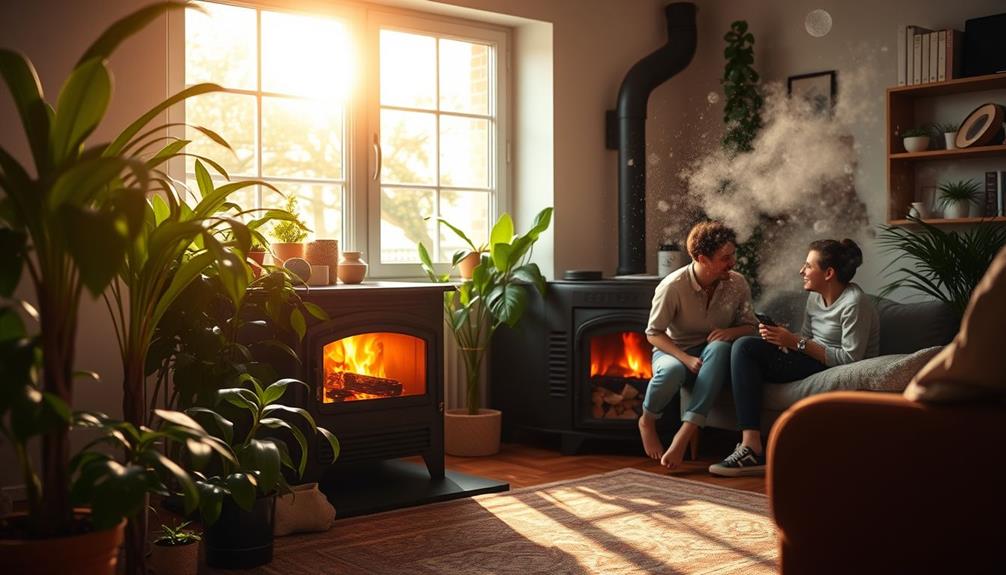
Considering the advancements in modern wood-burning stoves, you'll find that they can greatly improve indoor air quality when properly maintained. These stoves, equipped with advanced filtration systems, markedly reduce harmful emissions, resulting in average indoor PM2.5 levels of just 6-8 µg/m³. This is well within the World Health Organization's recommended safe limit of 10 µg/m³.
Additionally, adopting a holistic lifestyle approach, including stress management techniques, can further enhance the benefits of using these stoves by promoting a healthier home environment.
By opting for Ecodesign compliant stoves, you can enjoy a reduction in emissions by up to 90% compared to traditional open fires. This shift not only contributes to healthier indoor air quality but also supports a more sustainable lifestyle.
Proper usage and maintenance of wood stoves additionally enhance indoor air quality by minimizing the release of smoke and particulates.
Studies even indicate that using efficient wood stoves is linked to a decrease in respiratory issues, underscoring their positive impact on your home environment.
Research Supporting Wood Stove Benefits
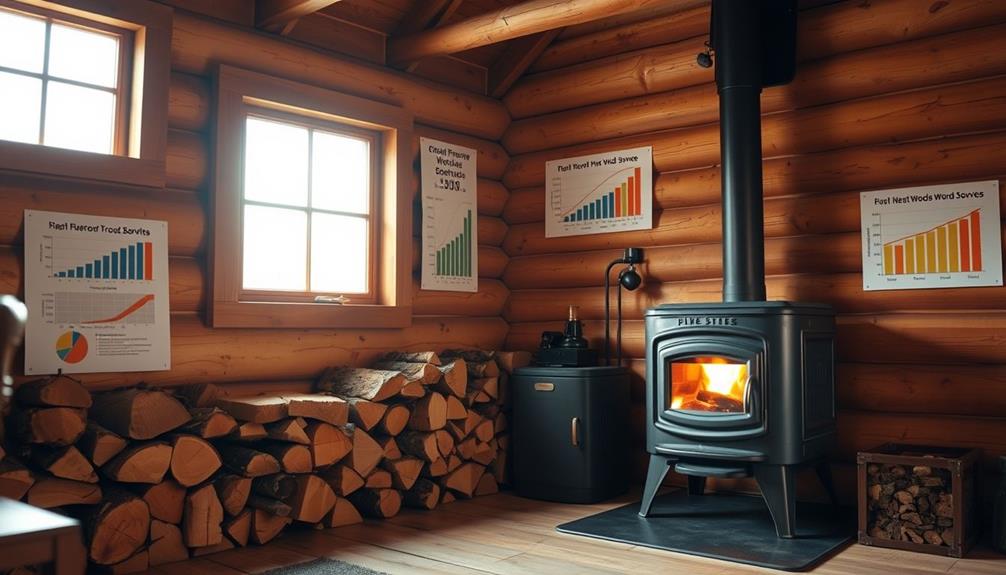
Research highlights the numerous benefits of modern wood-burning stoves, especially those adhering to Ecodesign standards. Recent studies show that these advanced stoves emit 66% less particulate matter than older models, demonstrating considerable improvements in efficiency and emissions reduction.
Proper maintenance is essential for peak performance, as it not only enhances efficiency but also guarantees that the stove operates within recommended safety and health standards. When properly maintained, wood-burning stoves can achieve indoor PM2.5 levels of just 6-8 µg/m³, comfortably within the World Health Organization's recommended daily average limit of 10 µg/m³.
Independent testing has confirmed that stoves like Burley, which feature advanced filtration systems, enhance indoor air quality by minimizing harmful emissions and reducing the respiratory health risks associated with indoor pollution.
Additionally, long-term research indicates that domestic wood-burning contributes only around 1-2% to PM2.5 emissions, a stark contrast to the often-quoted figure of 38%. This aligns with findings on cough with phlegm that suggest reducing indoor air pollutants can greatly improve respiratory health.
With ongoing research supporting the continued improvement of wood-burning stoves, manufacturers are dedicated to enhancing their efficiency and reducing their environmental impact.
This ongoing innovation underlines their potential as a sustainable heating option that aligns with both modern standards and your health needs.
Clean Air Strategy Insights
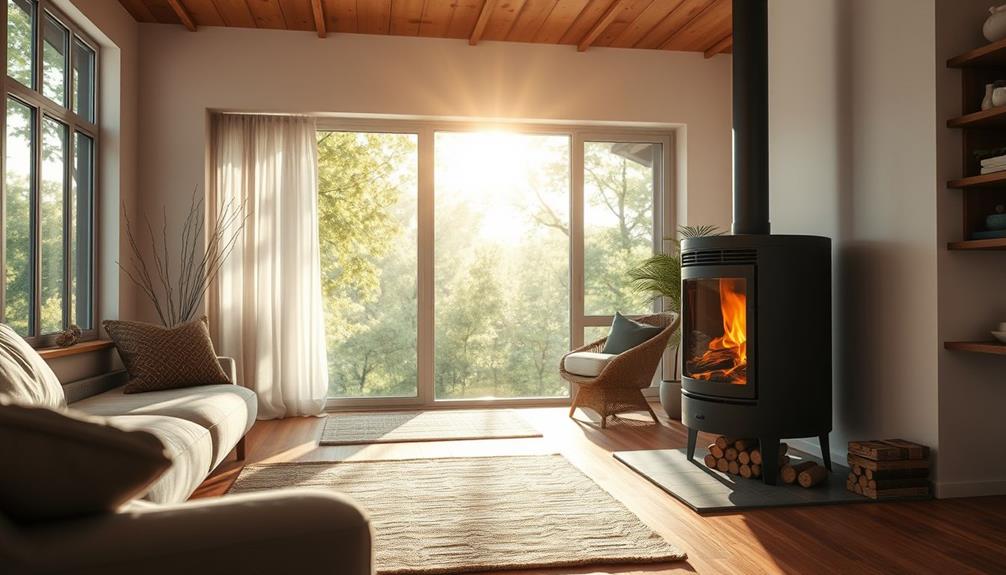
As part of the Clean Air Strategy launched in 2018, efforts are underway to tackle air pollution by focusing on domestic burning, which is identified as a considerable source of emissions. This strategy, part of Defra's 25-Year Environment Plan, aims to promote cleaner air while recognizing the role of wood stoves in sustainable heating.
Additionally, understanding the importance of responsible practices in heating methods can help mitigate environmental impacts, as noted in the push for cleaner burning practices.
The Environment Improvement Plan (EIP) 2023 confirms there's no intention to ban wood stoves. Instead, it encourages responsible burning practices and the sale of only the cleanest stoves. Regulations passed in 2020 prohibit the sale of wet wood and house coal, steering you towards certified fuels that support cleaner burning and reduce particulate emissions.
Local authorities now have new powers to enforce these regulations in high pollution areas, which helps improve air quality and public health. Your individual contributions matter too; by choosing cleaner fuels and maintaining your wood stove, you can greatly reduce your environmental impact.
The Clean Air Strategy emphasizes that together, we can enjoy the benefits of wood stoves while ensuring a healthier atmosphere for everyone.
Emission Regulations Overview
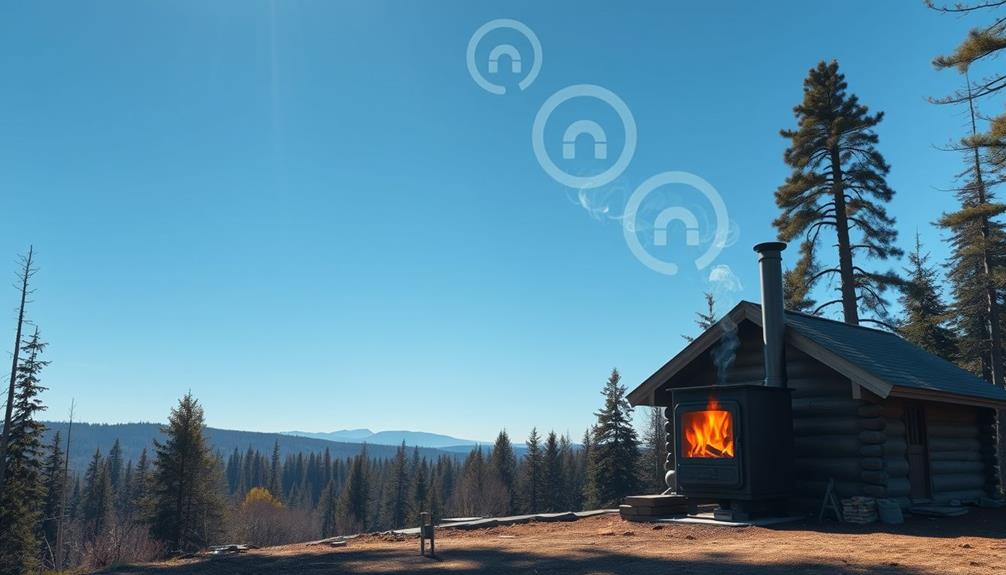
With the focus on cleaner air highlighted in the Clean Air Strategy, understanding the specific emission regulations is key for anyone using wood stoves.
Since the Air Quality (Domestic Solid Fuels Standards) Regulations passed in 2020, several significant changes have taken place to promote cleaner burning practices.
It's vital to explore how these regulations align with broader environmental goals, such as protecting your savings through sustainable practices.
You should be aware of the following points:
- The sale of wet wood is banned, emphasizing low moisture content for cleaner combustion.
- Only certified stoves that meet strict environmental standards are allowed for sale, ensuring you're using the best options available.
- Local authorities can now enforce regulations in high pollution areas, supporting efforts to improve air quality.
Importance of Professional Installation
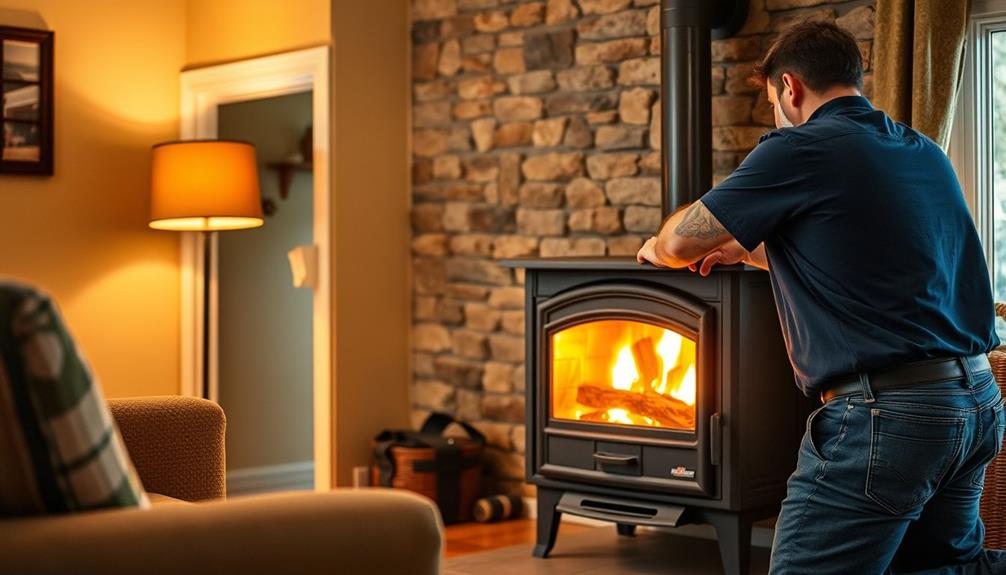
When it comes to installing a wood stove, you can't underestimate the importance of professional installation. Only HETAS-trained professionals should handle this task to ascertain compliance with safety regulations and standards.
Attempting to do it yourself or hiring someone unqualified can lead to incorrect installations that pose serious health risks through harmful leaks.
Furthermore, just like choosing a home cleaning service, it's crucial to evaluate the reputation and reviews of the installation expert to make sure you're making a sound decision.
Professional stove fitters have the expertise to install wood burners correctly, maximizing their efficiency and performance. They understand the intricate details that can make or break an installation, guaranteeing everything operates as it should.
Many local regulations require that wood burner installations are performed by certified professionals to ensure safe operation, so it's not just a recommendation—it's often a necessity.
Frequently Asked Questions
Why Are Wood-Burning Stoves Being Banned?
You might think wood-burning stoves are being banned, but that's not true. The focus is on promoting cleaner burning practices and reducing emissions, not on outright bans. Cleaner fuels and stoves will still be available.
Why It Is Not Advisable to Use a Wood Stove?
Did you know open fires lose about 80% of their heat? Using a wood stove can lead to air quality issues and safety risks if not installed or maintained properly, so it's best to think twice.
What Is the Greatest Problem Caused by the Use of Wood-Burning Stoves?
The greatest problem you face with wood-burning stoves is air pollution, primarily from particulate matter emissions. However, modern stoves considerably reduce this impact, especially when you use seasoned wood and maintain them properly.
Is Burning Wood in a Wood Stove Bad for the Environment?
Burning wood in a modern wood stove isn't necessarily bad for the environment. If you use sustainably sourced wood and well-seasoned logs, you'll minimize emissions and contribute to a cleaner air quality overall.
Conclusion
In the end, separating fact from fiction about wood stoves can feel like sifting through a pile of autumn leaves, revealing the vibrant truths hidden beneath. You've learned that, when used properly, these stoves can be efficient, eco-friendly, and safe for your home. By embracing the reality of wood stoves, you can warm your space with peace of mind, knowing you're making a responsible choice for both your comfort and the environment.




